Buy IGNOU MAEC Project for MECP 101/102
The IGNOU MAEC Project offers the learners an opportunity for higher studies in Economics. Besides offering the core courses available in other universities, it includes themes in some of the emerging areas in economics such as insurance, finance and computer applications that are expected to be extremely useful in the present scenario of economic liberalization and globalization. In this page problems associated with the writing and presentation of IGNOU MAEC Project are discussed, particularly with regard to the lack of skills in research design.
Whatsapp us to get the Personalized (Customized) IGNOU MAEC Project Report and Synopsis
Download Link for IGNOU MAEC Project (MECP 101/102 PDF)
What is the difference between MECP 101 and MECP 102?
MECP 101: Research Methods in Economics
Focus: This course is centered on the theoretical aspects of research methodology in economics. It provides the foundational knowledge required to design and conduct economic research.
Content:
- Introduction to research in economics
- Formulation of research questions and hypotheses
- Research design and planning
- Data collection methods (qualitative and quantitative)
- Sampling techniques
- Statistical tools and techniques for data analysis
- Writing research proposals
- Ethical considerations in research
Outcome: By the end of MECP 101, students should be able to understand and apply various research methods, design a research study, and write a research proposal.
MECP 102: Project Work in Economics
Focus: This course is practical and involves applying the research methods learned in MECP 101 to conduct a specific research project. Students independently carry out research on an economic topic of their choice.
Content:
- Selection of a research topic
- Developing a research proposal (based on the principles learned in MECP 101)
- Conducting literature review
- Data collection and analysis
- Interpretation of results
- Writing the project report
- Presentation of findings
Outcome: By the end of MECP 102, students will have completed a comprehensive research project, demonstrating their ability to conduct independent economic research, analyze data, and present their findings in a structured report.
Samples of IGNOU MAEC Project Topics for MECP 101/102
- Impact Of Mahatma Gandhi National Rural Employment Guarantee Act (Mgnrega) On Rural Livelihoods
- Role Of Ngos In Imparting Education Among Women
- Corporate Governance In Telecom Sector: A Theoretical Study
- Role Of Communication For The Development Of Rural Women With Special Reference To Self Help Group
- Consumer Behaviour In The Gold Jewellery Market
- Importance Of Rural Banks In The Rural Areas
What should be included in the IGNOU MAEC Project proposal?
The proposal should include:
- Title of the project
- Research question or hypothesis
- Objectives of the study
- Review of relevant literature
- Research methodology (data sources, methods of data collection, and analysis)
- Expected outcomes
- Timeline for completion
What is the word limit for the IGNOU MAEC Project report?
The word limit for the project report in the IGNOU MAEC program is typically around 10,000 to 15,000 words. However, it is essential to check the specific guidelines provided by IGNOU for your particular batch or course session, as requirements may vary. The word limit usually includes the main text of the report but excludes appendices, bibliography, and supplementary material. Always refer to the project’s handbook or consult with your supervisor for precise details regarding the word limit and other formatting requirements.
Can you include both primary and secondary data in your IGNOU MAEC Project (MECP 101/102)?
Yes, you can include both primary and secondary data in your project for the IGNOU MAEC program. Here’s how you can use each type of data:
Primary Data
- Definition: Data collected firsthand by the researcher for a specific research purpose.
- Methods of Collection: Surveys, interviews, experiments, observations, and questionnaires.
- Usage: Primary data is valuable for gaining insights directly from sources, especially when there is a need to gather specific, new, or detailed information.
- Examples: Conducting a survey to understand consumer behavior, interviewing experts on economic policies, or observing market trends.
Secondary Data
- Definition: Data that has already been collected by someone else for a different purpose but can be used for your research.
- Sources: Books, academic journals, government reports, statistical databases, industry reports, and online resources.
- Usage: Secondary data is useful for providing context, background, and supporting information to complement primary data. It can also help in identifying trends, making comparisons, and validating findings.
- Examples: Using government economic data, analyzing existing research studies, or referencing published statistics.
Combining Primary and Secondary Data
Combining both types of data can strengthen your research by providing a comprehensive view of your topic. Here’s how you can do it effectively:
- Literature Review: Use secondary data to review existing literature and identify gaps that your primary research will address.
- Research Design: Design your primary data collection methods based on insights gained from secondary data.
- Data Analysis: Compare and contrast primary data findings with secondary data to validate results and provide a robust analysis.
- Contextualization: Use secondary data to provide context and background information for your primary data findings.
Where do you submit your completed IGNOU MAEC Project report?
You need to submit your completed project report to the designated IGNOU study center or regional center. Here are the general steps you should follow:
Submission Steps
Finalize Your Report:
- Ensure your project report meets all formatting and content requirements specified by IGNOU.
- Proofread for errors and make any necessary revisions based on feedback from your supervisor.
Obtain Necessary Signatures:
- Get your project report approved and signed by your supervisor.
- Ensure that any required certificates (such as the certificate of originality) are signed.
Prepare Submission Materials:
- Print the required number of copies of your project report.
- Include any additional documents or forms required by IGNOU, such as the project proposal approval, supervisor’s certificate, and declaration of originality.
Submit to the Study/Regional Center:
- Identify the specific study center or regional center responsible for handling project submissions for your program.
- Visit the center in person to submit your project report. Alternatively, some centers may accept postal submissions; check with your center for their specific submission guidelines.
Obtain Receipt/Confirmation:
- Upon submission, request a receipt or confirmation of submission from the study center or regional center. This serves as proof that you have submitted your project report.
Verify Submission Requirements:
- Some centers might have specific submission windows or deadlines. Verify these details to ensure timely submission.
Important Tips
- Check Guidelines: Refer to the project guidelines provided by IGNOU for specific instructions on submission, including any required documentation.
- Confirm Submission Details: Contact your study center or regional center to confirm submission details, such as office hours, submission format (hard copy/electronic), and any other specific requirements.
- Keep Copies: Retain a copy of your project report and all submission documents for your records.
Contact Information
- Study Center/Regional Center: You can find the contact information for your study center or regional center on the IGNOU official website or through your student portal.
What is the role of the acknowledgment section in the IGNOU MAEC Project report?
The acknowledgment section in a MAEC project report serves several important purposes:
Express Gratitude:
- It allows you to formally thank individuals and institutions that have contributed to the successful completion of your project.
- Acknowledgments typically include your supervisor, faculty members, family, friends, colleagues, and any organizations that provided support or resources.
Recognize Contributions:
- This section provides a platform to recognize the contributions and assistance of others.
- Acknowledge people who offered guidance, feedback, mentorship, or technical support.
Demonstrate Ethical Conduct:
- Including an acknowledgment section shows academic and ethical conduct by giving credit where it is due.
- It highlights your awareness of the collaborative nature of research and study.
Build Relationships:
- By formally recognizing contributions, you help build and maintain professional and personal relationships.
- It reflects well on your character and can strengthen your network within your academic and professional communities.
Personal Touch:
- The acknowledgment section adds a personal touch to your project report, making it more relatable and sincere.
- It allows you to convey your appreciation in your own words, reflecting your unique experience.
Academic Mentors:
- Your project supervisor or advisor who provided guidance and support throughout the research process.
- Faculty members and instructors who offered insights or feedback on your work.
Institutional Support:
- Acknowledge the support from your university or department.
- Any funding bodies, libraries, or research centers that facilitated your work.
Professional Assistance:
- Individuals who assisted with technical aspects, such as data collection, analysis, or editing.
- Professionals or experts who provided valuable information or insights relevant to your project.
Personal Support:
- Family and friends who provided emotional support, encouragement, or practical help.
- Colleagues or peers who collaborated with you or offered constructive feedback.
What is the significance of the findings and discussion section for your IGNOU MAEC Project?
The findings and discussion section is a crucial part of your project report as it showcases the results of your research and interprets their significance. Here’s a detailed look at its significance and what it typically includes:
Significance of the Findings and Discussion Section
Presentation of Results:
- This section provides a detailed account of the data you collected during your research.
- It presents the findings in a clear and organized manner, often using tables, charts, graphs, and other visual aids to enhance understanding.
Interpretation of Data:
- Beyond just presenting the raw data, this section interprets what the data means in the context of your research question or hypothesis.
- It explains the relevance of the findings and how they answer the research questions posed at the beginning of your study.
Comparison with Existing Literature:
- The discussion part often involves comparing your results with previous studies or theoretical frameworks.
- It highlights how your findings align with or diverge from existing knowledge, thereby contributing to the academic discourse.
Explanation of Unexpected Results:
- If your findings include any unexpected results or anomalies, this section provides an opportunity to explore and explain these occurrences.
- It discusses potential reasons for these unexpected outcomes and their implications for the field.
Implications of the Study:
- This section outlines the broader implications of your findings for theory, practice, policy, or future research.
- It discusses how your research contributes to the field of economics and what impact it might have on real-world issues or further academic inquiries.
Addressing Limitations:
- It acknowledges any limitations or constraints that might have affected the results of your study.
- By discussing these limitations, you provide a balanced view of your research and suggest areas for improvement in future studies.
Recommendations:
- Based on your findings, this section can include recommendations for practitioners, policymakers, or other researchers.
- It suggests practical applications of your research and areas where further investigation is needed.
Can you include recommendations in your IGNOU MAEC Project report?
Yes, you can include recommendations in your MAEC project report. In fact, including recommendations is often a critical part of your project report as it demonstrates your ability to apply the findings of your research to real-world situations or future studies. Here’s how you can effectively include recommendations in your project report:
Significance of Recommendations
Practical Application:
- Recommendations offer practical solutions or suggestions based on your research findings.
- They help translate theoretical knowledge into actionable steps.
Contribution to Field:
- They highlight the potential impact of your research on the field of study.
- Recommendations can guide policymakers, practitioners, and future researchers.
Addressing Gaps:
- Recommendations often address the gaps identified during the research.
- They suggest areas for improvement or further investigation.
Value Addition:
- Including well-thought-out recommendations adds value to your research.
- It shows a comprehensive understanding of the subject and critical thinking.
Ready to get your IGNOU MAEC Project Report and Synopsis Sample PDF for MECP 101/102?
- Call us or WhatsApp us at: 9958947060, 9354637830
- Visit: SHRICHAKRADHAR.COM
-
Sale!
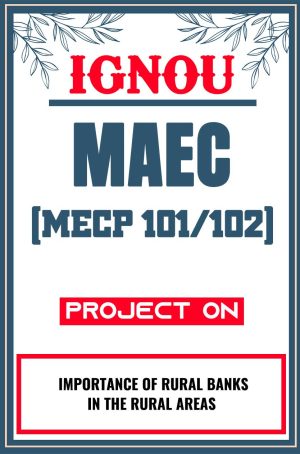
-
Sale!
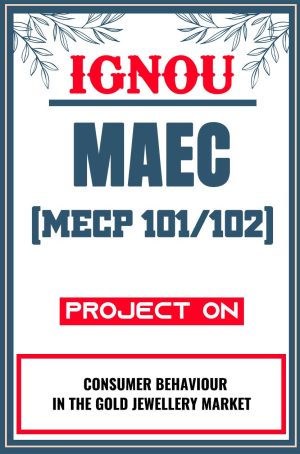
IGNOU MAEC Project (MECP 101/102) Synopsis/Proposal & Project Report/Dissertation in Hard-Copy (Sample-5)
Original price was: ₹499.00.₹249.00Current price is: ₹249.00. -
Sale!
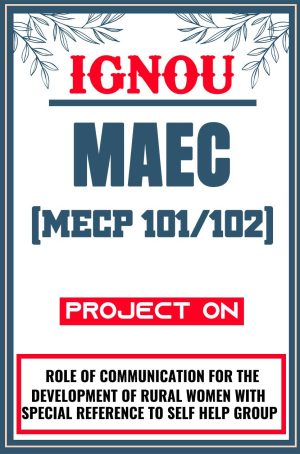
IGNOU MAEC Project (MECP 101/102) Synopsis/Proposal & Project Report/Dissertation in Hard-Copy (Sample-4)
Original price was: ₹499.00.₹249.00Current price is: ₹249.00. -
Sale!
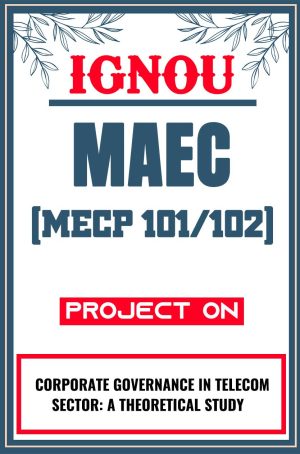
IGNOU MAEC Project (MECP 101/102) Synopsis/Proposal & Project Report/Dissertation in Hard-Copy (Sample-3)
Original price was: ₹499.00.₹249.00Current price is: ₹249.00. -
Sale!

IGNOU MAEC Project (MECP 101/102) Synopsis/Proposal & Project Report/Dissertation in Hard-Copy (Sample-2)
Original price was: ₹499.00.₹249.00Current price is: ₹249.00. -
Sale!
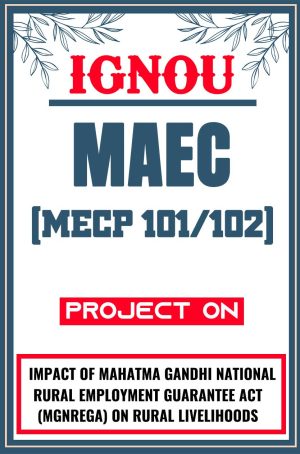
IGNOU MAEC Project (MECP 101/102) Synopsis/Proposal & Project Report/Dissertation in Hard-Copy (Sample-1)
Original price was: ₹499.00.₹249.00Current price is: ₹249.00.
